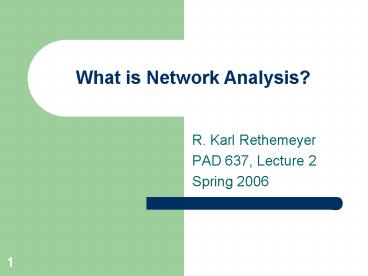What is Network Analysis - PowerPoint PPT Presentation
1 / 15
Title:
What is Network Analysis
Description:
Capture of Saddam Hussein. Breaking up terrorist cells. SARS Epidemic ... Friendster. Political books. Baconizer. Business use of SNA. 3 ... – PowerPoint PPT presentation
Number of Views:93
Avg rating:3.0/5.0
Title: What is Network Analysis
1
What is Network Analysis?
- R. Karl Rethemeyer
- PAD 637, Lecture 2
- Spring 2006
2
Network analysis in the news
- Business 2.0 2003 Technology of the Year
Social Network Analysis - Capture of Saddam Hussein
- Breaking up terrorist cells
- SARS Epidemic
- Small world phenomenon - on the Internet
- Web-based tools to analyze linkages
- Friendster
- Political books
- Baconizer
- Business use of SNA
3
A brief history and mathematical background
- Sociology Moreno and sociometry the sociogram
(1930s) graphical presentations of networks - Social psychology Harary, Norman Cartwright
the sociomatrix (1940s to 50s) matrices
algorithms - Anthropology Barnes Mitchell structuralism
and complex societies (1950s to 70s) measures - Mathematical graph theory provided key but
deterministic ideas and measures problems with
random graphs - Mathematical sociology Holland, Leinhardt,
Wasserman, etc. (1980s to ???) statistical
models - Focus on empiricism and measurement
4
Fundamental assumptions
- Social life is about interdependence, not
independence - Social entities make non-random, non-trivial
connections - Relations are at least as important as attributes
and norms in fact, attributes norms may flow
from relations - Patterns of interconnection matter because they
support flows of resources material
non-material - Direct indirect relations matter collusion,
for instance - The broader structure matters and may be
constitutive substructure - Persistent connections are what matter social
structure - Social structure enables and constrains action
- Access is related to resources, power,
influence - brokerage - Networks are dualistic
- They help to shape action
- They are reproduced through action
- They change through purposive action random
events
5
Fundamental uses of network analysis
- Formal description
- Creation of formal, mathematical ways to describe
relational concepts - May be an end in itself (social X-ray), may
contribute to traditional methods, or be an
adjunct to - Model and theory evaluation testing
- Provides the basic toolkit for measuring
relational concepts - Provides deterministic and probabilistic means of
testing models and theory
6
Fundamental concepts
- Actor/node
- Any independent social entity persons, groups,
organizations - Ties/edges
- Any persistent communication or exchange
relationship between two nodes may be
directional varying in strength - Relations
- A collection of ties of a specific kind among
members of a group - Networks
- A set of actors are that related by ties across
one or more relations
7
Data collection methods
- Sampling gives way to complete population studies
- Network sampling is extremely difficult
- Populations specified by research criteria or by
consensus among a population - Data collection
- Archival analysis
- Interviews
- Surveys
- Analysis of passively collected data e-mail
logs, contacts databases, telephone logs, etc.
8
Fundamental types of analysis
- Visualization A social X-ray. Used to visually
identify relationships or substructures - Often done in conjunction with analytic routines
like multidimensional scaling, factor analysis,
etc. - Can be diagnostic without additional analysis
- Terror cells Terror syndicates
- Policy networks
- Actor-level analysis used to find graph
theoretic properties of actors, which are often
used as proxies for other concepts - Example centrality and power structural holes
9
Fundamental types of analysis
- Subgraph analysis Identification of subgroups
in a single relation - Cliques cohesive social groups
- Core/periphery structures policy networks
- Positional analysis Identification of
equivalent subgroups in a network using
multiple relations - Example core/periphery patterns in trade data
10
Fundamental types of analysis
- Two-mode analysis Measurement of relationship
between a group of actors and a group of events - Participation of social movement orgs. In
protests - Ego-centric analysis Use of network concepts
within the context of standard regression models - Example GSS and measures of ego networks
- Statistical analysis Models of network
structure that include both network and
compositional data - Examples Gender choice and play in elementary
school communication preference in policy
networks
11
Fundamental questions in SNA
- Which actor is most powerful?
- Do actors form cohesive subgroups?
- Do actors form preferential connections with some
other actors? - Do networks display core-periphery structures?
- Are actors in a network divided into subgroups
that have similar patterns of connections? - How to networks change over time?
12
Empirical questions addressed with social network
analysis
- Is there a core-periphery structure to world
trade? - Which actors have preferential access to public
decisionmakers? - Does the structure of public service networks in
mental health affect patient outcomes? - If school superintendents spend time cultivating
relationships with school boards, does that tend
to improve or degrade school performance? - Are there really only six degrees of separation
in the Internet age?
13
Empirical questions addressed with social network
analysis
- Is the Internet tending to broaden or contract
access to public decisionmakers? - How much do key innovations in the information
age owe to patents gotten through publicly-funded
research? - Are job seekers more likely to find a job using
an online service or a friend?
14
Work that is beginning/continuing here
- Karl Rethemeyer Longitudinal study of policy
networks and the Internets impact on them - Ramon Gil-Garcia/CTG Study of the social network
among September 11th first-day responders in the
GIS community - Amy Smith Study of the social networks that
connect securities regulators and the firms that
are regulated - Triparna Vasavada Study of genders impact on
government-NGO relations in India focus on
disaster mitigation groups - Asal (Poli Sci), Rethemeyer, Study of terrorist
syndicates and terrorist virtual networks
15
Discussion How does this connect to other
traditions used here?
- System dynamics
- Decision analysis
- Economic modeling































